- Library Catalogue

Templates for structuring argumentative essays with practice exercises and solutions
On this page, thesis statement, referring to others’ work.
- Using impersonal language
Agreeing with what you’ve reviewed in the “They say” section
Disagreeing with what you’ve reviewed in the “they say” section.
- Agreeing and disagreeing simultaneously
My critics say
This page introduces a framework for writing argumentative/analytical essays, following a structure dubbed “They Say, I Say, My Critics Say, I Respond.” [1]
This page also includes a number of templates [2] or examples that you may find helpful for writing argumentative/analytical essays. Keep in mind that it is possible to change the sequence of the framework sections. Also, the templates can be used interchangeably.
A principal element of an argumentative/analytical essay is the thesis statement.
A thesis statement is one or two sentences (maybe more in longer essays) typically occurring near the end of an essay introduction; it shows your position regarding the topic you are investigating or your answer(s) to the question(s) that you are responding to.
Here are some templates that may help you write an effective thesis statement:
- In this paper, I argue that .......... because ..........
- In the pages that follow, I will argue that .......... because ..........
- Although/Even though .......... this essay argues that/I will argue that .......... because ..........
- This paper attempts to show that ..........
- This paper contests the claim that ..........
- This paper argues that ..........
- The central thesis of this paper is ..........
- In this essay, I attempt to defend the view that ..........
Thesis statement exercise and solutions
Imagine that you have been asked to write an argumentative essay about physical education in the Canadian high school system. Use one of the templates suggested to write a thesis statement about this topic.
- In the pages that follow, I will argue that physical education in the Canadian high school system has been largely ineffective because it has remained limited in its range of exercises and has failed to connect with students’ actual interests, such a dance and martial arts.
- This paper attempts to show that physical education is a crucial aspect of the Canadian high school system because many teenagers do not experience encouragement to do physical activity outside of school and contemporary life is increasingly sedentary for people of all ages.
The body of an essay usually begins by providing a background of the topic or a summary of the resources that you have reviewed (this is sometimes called a literature review). Here, you bring other people’s views into the paper. You want to show your readers what other scholars say (“they say”) about the topic, using techniques like paraphrasing, summarizing, and direct quotation.
You can start this section using one the following templates or examples to delve into the topic.
They say exercise and solutions
Imagine that you are now trying to incorporate some sources into your academic paper about physical education in the Canadian high school system. Try using a couple of templates from the “They Say” section of the handout.
Bonus exercise: See if you can identify the “template” structure that each of the sentences below is using (hint, they are different from the templates provided above).
- Brown (2018) rejects the idea that the levels of climate change we are currently seeing can be considered “natural” or “cyclical” (p. 108).
- According to Marshall (2017), we can see evidence of both code-switching and code-meshing in students’ reflective essay writing (p. 88).
- Previous studies of physical education have revealed that teenagers experience a significant degree of dissatisfaction with their gym classes (Wilson, 2010; Vowel et al, 1999; Mossman, 1986).
- A number of studies conducted prior to the 1990s have demonstrated that teenagers used to experience more encouragement to engage in physical activities outside of school hours (Sohal, 1954; Silverman, 1965; Lu, 1970; Mossman, 1986).
- Jones’ (2017) investigations of sedentariness among young people have shown significant increases in illness among teenagers who do not engage in regular physical activity.
After the background section (e.g., summary or literature review), you need to include your own position on the topic (“I say”). Tell your reader if, for instance, you agree, disagree, or even both agree and disagree with the work you have reviewed.
You can use one of the following templates or samples to bring your voice in:
- It could be argued that ..........
- It is evident/clear/obvious that the role of modern arts is ..........
- Clearly/Evidently, the role of education is ..........
- There is no little doubt that ..........
- I agree (that) ..........
- I support the view that ...........
- I concur with the view that ..........
- I disagree (that) ..........
- I disagree with the view that ..........
- I challenge/contest the view that ..........
- I oppose/am opposed to ..........
- I disagree with X’s view that .......... because, as recent research has shown, ..........
- X contradicts herself/can’t have it both ways. On the one hand, she argues ........... On the other hand, she also says ..........
- By focusing on .........., X overlooks the deeper problem of ..........
- Although I agree with X up to a point, I cannot accept his overriding assumption that ..........
- Although I disagree with much that X says, I fully endorse his final conclusion that ..........
- Though I concede that .........., I still insist that ..........
- X is right that .........., but she seems on more dubious ground that when she claims that ..........
- While X is probably wrong when she claims tha ..........., she is right that ..........
- Whereas X provides ample evidence that .........., Y and Z’s research on .......... and .......... convinces me that .......... instead.
- I’m of two minds about X’s claim that ........... On the one hand, I agree that .......... On the other hand, I’m not sure if ..........
- My feelings on the issue are mixed. I do support X’s position that .........., but I find Y’s argument about .......... and Z’s research on .......... to be equally persuasive.
I say exercises and solutions
Try using a template from each of the sections below to bring your own position into your writing:
- Agreeing with what you’ve reviewed
- Disagreeing with that you’ve reviewed
Using impersonal language There is little doubt that the teenage years are important for establishing life-long habits.
Agreeing with what you’ve reviewed in the “They say” section I support the view, presented by Vowel et al (1999) that effective physical education needs to consider the heightened self-consciousness that many teenagers experience and, in particular, needs to be sensitive to the body image issues that can be pervasive among young people.
Disagreeing with what you’ve reviewed in the “They say” section By focusing on school physical education programs and their shortcomings, Wilson (2010) overlooks the deeper problem that young people are experiencing a lack of motivation to incorporate healthy exercise into their daily lives.
Agreeing and Disagreeing simultaneously Though I concede that school physical education programs are valuable, I still insist that they cannot be the sole or even the primary way that we promote an active lifestyle among young people.
In a good argumentative essay, in addition to expressing your position and argument, you should consider possible opposing views to your argument: refer to what your opponents say (“my critics say”) and why they may disagree with your argument.
Including the ideas of those who may disagree with you makes up the counterargument section of your paper. You can refer to actual people, including other research scholars who may disagree with you, or try and imagine what those who disagree with you might say.
Remember, a thesis should be debatable, so you should be able to imagine someone disagreeing you’re your position. Here are some templates that may help you in writing counterargument:
My critics say exercise and solutions
Using one of the templates, try imagining a counterargument for the thesis you drafted earlier.
Sociocultural theorists used to believe that adolescence was a time of “natural defiance” (Fung, 1995) and therefore discounted the role of educational programs aimed at supporting teenagers to form healthy habits. Much of the focus of schooling therefore became about teaching specific content and skills.
Critics may call into question my assumption that effective physical education can help establish life-long healthy living habits.
After explaining what your opponents say, you have to refute them. This is sometimes called the rebuttal. Here, you can show your readers that your opponents either fail to provide enough evidence to support their argument or their evidence lacks credibility and/or is flawed.
Alternatively, you may argue that your opponents’ argument is valid, but not persuasive enough to be used in your study, or that their argument could be valid in a different context.
Don’t forget that for each part of your argument, you must provide enough evidence for the claims that you make. This means that if you include one of these templates in your essays, you have to explain the evidence it presents in a way that is clear and convincing for your reader.
I respond exercise and solutions
Using one of the templates, craft a rebuttal to the counterargument you just created.
Sociocultural theorists used to believe that adolescence was a time of “natural defiance” (Fung, 1995) and therefore discounted the role of educational programs aimed at supporting teenagers to form healthy habits. Much of the focus of schooling therefore became about teaching specific content and skills. However, this argument fails to demonstrate that the defiance observed during adolescence was “natural” or inherent and not a product of a specific cultural environment. It therefore does not convince me that education during the adolescent years needs to remain rigidly focused on content and skills.
Critics may call into question my assumption that effective physical education can help establish life-long healthy living habits. While it is true that we cannot assume that physical education will automatically lead to the establishment of healthy habits, I maintain that the creation of such habits, rather than simply teaching specific physical education content or skills, should be the central goal of an effective physical education program.
Graff, G., & Birkenstein, C. (2017). They say / I say: The moves that matter in academic writing, with readings (3rd ed.). New York: Norton W. W. Company.
Marshall, S. (2017). Advance in academic writing: Integrating research, critical thinking, academic reading and writing. Toronto, Canada: Pearson Education ESL.
Morley, J. (2014). Academic phrasebank. Retrieved from http://www.phrasebank.manchester.ac.uk/
[1] Adapted from Graff and Birkenstein (2016).
[2] The templates used in this handout are adapted from Morley (2014), Marshall (2017), and Graff and Birkenstein (2016).
English Grammar Online Exercises and Downloadable Worksheets
Essay writing.
In this section you can find writing topics and prompts for students . Material covers essays, letters. emails, articles and others. For each topic there is also a PDF - printer-friendly version available.
Argumentative Essays - Opinion Essays
- ESS010 - Basic Income
- ESS009 - Strict Parenting
- ESS008 - Visiting Museums
- ESS007 - Vegetarianism
- ESS006 - School Sports
- ESS005 - Cyberbullying - Opinion Essay
- ESS001 - Shopping Mall or Sports Ground - Argumentative Essay
- ESS002 - Computers and the Internet
- ESS003 - New Media
- ESS004 - School Sport
Online Exercises
- Gerund - Infinitive
- Adjective - Adverb
- Modal Verbs
- Passive Voice
- Reported Speech
- Definite and Indefinite Articles
- Prepositions
- Connectives and Linking Words
- Quantifiers
- Question and Negations
- Relative Pronouns
- Indefinite Pronouns
- Possessive Pronouns
- Phrasal Verbs
- Common Mistakes
- Missing Word Cloze
- Word Formation
- Multiple Choice Cloze
- Prefixes and Suffixes
- Key Word Transformation
- Editing - One Word Too Many
- Collocations
- General Vocabulary
- Adjectives - Adverbs
- Gerund and Infinitive
- Conjunctions and Linking Words
- Question and Negation
- Error Analysis
- Translation Sentences
- Multiple Choice
- Banked Gap Fill
- Open Gap Fill
- General Vocabulary Exercises
- Argumentative Essays
- Letters and Emails
- English News Articles
- Privacy Policy
- Chess (Gr. 1-4)
- TV (Gr. 1-4)
- Metal Detectors (Gr. 2-6)
- Tetris (Gr. 2-6)
- Seat Belts (Gr. 2-6)
- The Coliseum (Gr. 2-6)
- The Pony Express (Gr. 2-6)
- Wintertime (Gr. 2-6)
- Reading (Gr. 3-7)
- Black Friday (Gr. 3-7)
- Hummingbirds (Gr. 3-7)
- Worst Game Ever? (Gr. 4-8)
- Carnivorous Plants (Gr. 4-8)
- Google (Gr. 4-8)
- Honey Badgers (Gr. 4-8)
- Hyperinflation (Gr. 4-8)
- Koko (Gr. 4-8)
- Mongooses (Gr. 5-9)
- Trampolines (Gr. 5-9)
- Garbage (Gr. 5-9)
- Maginot Line (Gr. 5-9)
- Asian Carp (Gr. 5-9)
- Tale of Two Countries (Gr. 6-10)
- Kevlar (Gr. 7-10)
- Tigers (Gr. 7-11)
- Statue of Liberty (Gr. 8-10)
- Submarines (Gr. 8-12)
- Castles (Gr. 9-13)
- Gutenberg (Gr. 9-13)
- Author's Purpose Practice 1
- Author's Purpose Practice 2
- Author's Purpose Practice 3
- Fact and Opinion Practice 1
- Fact and Opinion Practice 2
- Fact and Opinion Practice 3
- Idioms Practice Test 1
- Idioms Practice Test 2
- Figurative Language Practice 1
- Figurative Language Practice 2
- Figurative Language Practice 3
- Figurative Language Practice 4
- Figurative Language Practice 5
- Figurative Language Practice 6
- Figurative Language Practice 7
- Figurative Language Practice 8
- Figurative Language Practice 9
- Figurative Language of Edgar Allan Poe
- Figurative Language of O. Henry
- Figurative Language of Shakespeare
- Genre Practice 1
- Genre Practice 2
- Genre Practice 3
- Genre Practice 4
- Genre Practice 5
- Genre Practice 6
- Genre Practice 7
- Genre Practice 8
- Genre Practice 9
- Genre Practice 10
- Irony Practice 1
- Irony Practice 2
- Irony Practice 3
- Making Inferences Practice 1
- Making Inferences Practice 2
- Making Inferences Practice 3
- Making Inferences Practice 4
- Making Inferences Practice 5
- Main Idea Practice 1
- Main Idea Practice 2
- Point of View Practice 1
- Point of View Practice 2
- Text Structure Practice 1
- Text Structure Practice 2
- Text Structure Practice 3
- Text Structure Practice 4
- Text Structure Practice 5
- Story Structure Practice 1
- Story Structure Practice 2
- Story Structure Practice 3
- Author's Purpose
- Characterizations
- Context Clues
- Fact and Opinion
- Figurative Language
- Grammar and Language Arts
- Poetic Devices
- Point of View
- Predictions
- Reading Comprehension
- Story Structure
- Summarizing
- Text Structure
- Character Traits
- Common Core Aligned Unit Plans
- Teacher Point of View
- Teaching Theme
- Patterns of Organization
- Project Ideas
- Reading Activities
- How to Write Narrative Essays
- How to Write Persuasive Essays
- Narrative Essay Assignments
- Narrative Essay Topics
- Persuasive Essay Topics
- Research Paper Topics
- Rubrics for Writing Assignments
- Learn About Sentence Structure
- Grammar Worksheets
- Noun Worksheets
- Parts of Speech Worksheets
- Punctuation Worksheets
- Sentence Structure Worksheets
- Verbs and Gerunds
- Examples of Allitertion
- Examples of Hyperbole
- Examples of Onomatopoeia
- Examples of Metaphor
- Examples of Personification
- Examples of Simile
- Figurative Language Activities
- Figurative Language Examples
- Figurative Language Poems
- Figurative Language Worksheets
- Learn About Figurative Language
- Learn About Poetic Devices
- Idiom Worksheets
- Online Figurative Language Tests
- Onomatopoeia Worksheets
- Personification Worksheets
- Poetic Devices Activities
- Poetic Devices Worksheets
- About This Site
- Privacy Policy
- Terms of Use
- Understanding CCSS Standards
- What's New?
Ereading Worksheets
Free reading worksheets, activities, and lesson plans., site navigation.
- Learn About Author’s Purpose
- Author’s Purpose Quizzes
- Character Types Worksheets and Lessons
- List of Character Traits
- Differentiated Reading Instruction Worksheets and Activities
- Fact and Opinion Worksheets
- Irony Worksheets
- Animal Farm Worksheets
- Literary Conflicts Lesson and Review
- New Home Page Test
- Lord of the Flies Chapter 2 Worksheet
- Lord of the Flies Chapter 5 Worksheet
- Lord of the Flies Chapter 6 Worksheet
- Lord of the Flies Chapter 10 Worksheet
- Narrative of the Life of Frederick Douglass
- Sister Carrie
- The Count of Monte Cristo
- The Odyssey
- The War of the Worlds
- The Wizard of Oz
- Mood Worksheets
- Context Clues Worksheets
- Inferences Worksheets
- Main Idea Worksheets
- Making Predictions Worksheets
- Nonfiction Passages and Functional Texts
- Setting Worksheets
- Summarizing Worksheets and Activities
- Short Stories with Questions
- Story Structure Activities
- Story Structure Worksheets
- Tone Worksheets
- Types of Conflict Worksheets
- Reading Games
- Figurative Language Poems with Questions
- Hyperbole and Understatement Worksheets
- Simile and Metaphor Worksheets
- Simile Worksheets
- Hyperbole Examples
- Metaphor Examples
- Personification Examples
- Simile Examples
- Understatement Examples
- Idiom Worksheets and Tests
- Poetic Devices Worksheets & Activities
- Alliteration Examples
- Allusion Examples
- Onomatopoeia Examples
- Onomatopoeia Worksheets and Activities
- Genre Worksheets
- Genre Activities
- Capitalization Worksheets, Lessons, and Tests
- Contractions Worksheets and Activities
- Double Negative Worksheets
- Homophones & Word Choice Worksheets
- ‘Was’ or ‘Were’
- Simple Subjects & Predicates Worksheets
- Subjects, Predicates, and Objects
- Clauses and Phrases
- Type of Sentences Worksheets
- Sentence Structure Activities
- Comma Worksheets and Activities
- Semicolon Worksheets
- End Mark Worksheets
- Noun Worksheets, Lessons, and Tests
- Verb Worksheets and Activities
- Pronoun Worksheets, Lessons, and Tests
- Adverbs & Adjectives Worksheets, Lessons, & Tests
- Preposition Worksheets and Activities
- Conjunctions Worksheets and Activities
- Interjections Worksheets
- Parts of Speech Activities
- Verb Tense Activities
- Past Tense Worksheets
- Present Tense Worksheets
- Future Tense Worksheets
- Point of View Activities
- Point of View Worksheets
- Teaching Point of View
- Cause and Effect Example Paragraphs
- Chronological Order
- Compare and Contrast
- Order of Importance
- Problem and Solution
- Text Structure Worksheets
- Text Structure Activities
- Essay Writing Rubrics
- Narrative Essay Topics and Story Ideas
- Narrative Essay Worksheets & Writing Assignments
- Persuasive Essay and Speech Topics
Persuasive Essay Worksheets & Activities
- Writing Narrative Essays and Short Stories
- Writing Persuasive Essays
- All Reading Worksheets
- Understanding Common Core State Standards
- Remote Learning Resources for Covid-19 School Closures
- What’s New?
- Ereading Worksheets | Legacy Versions
- Online Figurative Language Practice
- Online Genre Practice Tests
- Online Point of View Practice Tests
- 62 School Project Ideas
- 2nd Grade Reading Worksheets
- 3rd Grade Reading Worksheets
- 4th Grade Reading Worksheets
- 5th Grade Reading Worksheets
- 6th Grade Reading Worksheets
- 7th Grade Reading Worksheets
- 8th Grade Reading Worksheets
- 9th Grade Reading Worksheets
- 10th Grade Reading Worksheets
- Membership Billing
- Membership Cancel
- Membership Checkout
- Membership Confirmation
- Membership Invoice
- Membership Levels
- Your Profile
Want Updates?
84 comments.
Thank you so much. This has truly helped me in my exams and throughout the beneficial journey of my school year.
Ellen Davis
How will I be able to check my work, when I print it out to work on them? Where are the answers?
I guess it depends on what you are working on. On what are you working?
Kareema Coles
Ummm the pdf version is not working…is the link still valid?
Which link?
This is an amazing website with fabulous ideas and printable ready to go lessons!!! Thank you so much! I wish I could meet you!!!
Thank you very much for this amazing resource and great ideas. They are extremely comprehensive and well designed. Thank you very much for your kind consideration and not adding a Price-tag to your valuable resources. Highly appreciated.
Sandra Conner
Thank you so much for sharing your knowledge and your work with us. As teachers, we are always in need of fresh material. I teach college level creative writing classes, and your worksheets help my students. Sometimes I change the essay topics to fit their particular age group or interest, but having these examples laid out for us and made available for use in our classrooms is wonderful.
Lifesaver! Thank you for the great ideas and guidance. I am a new teacher, and finding this site has made a true turn around in my instruction. Thank you, thank you, thank you!!!
Thank you for these great step by step resources
Macca Malbrán
Despite all the negative comments above, you should keep up for the ones (like me) who are absolutely grateful for these material.
Thanks for sharing! Best.
I give this website 3stares only for the info but in general 1star
I give your comment 0 stars because your position lacks support or evidence of any kind. Complete some of these worksheets and begin your argument again.
that’s stupid from where do u get the worksheets
I wrote them.
I did not see any activities that required the student to write an entire essay.
https://www.ereadingworksheets.com/writing/persuasive-essay-topics/
Lamar Mohamed
Thank you for this information! They helped me in my exam so much!
These are fantastic resources! Thank you so much for sharing them. I only wish I had found them earlier in the school year!
There’s always next year…
Thank you so much for all you do for teachers. I love an use practically everything on your Website!
That’s awesome. Thanks for visiting my website.
I really like this website
Shenard McDougal
How can a teacher get the answers to the worksheets?
Leave a Reply Cancel reply
Your email address will not be published. Required fields are marked *
Subscribe Now
Popular content.
- Author's Purpose Worksheets
- Characterization Worksheets
- Common Core Lesson and Unit Plans
- Online Reading Practice Tests
- Plot Worksheets
- Reading Comprehension Worksheets
- Summary Worksheets
- Theme Worksheets
New and Updated Pages
- Capitalization Worksheets
- Contractions Worksheets
- Double Negatives Worksheets
- Homophones & Word Choice Worksheets
BECOME A MEMBER!
Have a language expert improve your writing
Run a free plagiarism check in 10 minutes, generate accurate citations for free.
- Knowledge Base
- How to write an argumentative essay | Examples & tips
How to Write an Argumentative Essay | Examples & Tips
Published on July 24, 2020 by Jack Caulfield . Revised on July 23, 2023.
An argumentative essay expresses an extended argument for a particular thesis statement . The author takes a clearly defined stance on their subject and builds up an evidence-based case for it.
Instantly correct all language mistakes in your text
Upload your document to correct all your mistakes in minutes

Table of contents
When do you write an argumentative essay, approaches to argumentative essays, introducing your argument, the body: developing your argument, concluding your argument, other interesting articles, frequently asked questions about argumentative essays.
You might be assigned an argumentative essay as a writing exercise in high school or in a composition class. The prompt will often ask you to argue for one of two positions, and may include terms like “argue” or “argument.” It will frequently take the form of a question.
The prompt may also be more open-ended in terms of the possible arguments you could make.
Argumentative writing at college level
At university, the vast majority of essays or papers you write will involve some form of argumentation. For example, both rhetorical analysis and literary analysis essays involve making arguments about texts.
In this context, you won’t necessarily be told to write an argumentative essay—but making an evidence-based argument is an essential goal of most academic writing, and this should be your default approach unless you’re told otherwise.
Examples of argumentative essay prompts
At a university level, all the prompts below imply an argumentative essay as the appropriate response.
Your research should lead you to develop a specific position on the topic. The essay then argues for that position and aims to convince the reader by presenting your evidence, evaluation and analysis.
- Don’t just list all the effects you can think of.
- Do develop a focused argument about the overall effect and why it matters, backed up by evidence from sources.
- Don’t just provide a selection of data on the measures’ effectiveness.
- Do build up your own argument about which kinds of measures have been most or least effective, and why.
- Don’t just analyze a random selection of doppelgänger characters.
- Do form an argument about specific texts, comparing and contrasting how they express their thematic concerns through doppelgänger characters.
Receive feedback on language, structure, and formatting
Professional editors proofread and edit your paper by focusing on:
- Academic style
- Vague sentences
- Style consistency
See an example

An argumentative essay should be objective in its approach; your arguments should rely on logic and evidence, not on exaggeration or appeals to emotion.
There are many possible approaches to argumentative essays, but there are two common models that can help you start outlining your arguments: The Toulmin model and the Rogerian model.
Toulmin arguments
The Toulmin model consists of four steps, which may be repeated as many times as necessary for the argument:
- Make a claim
- Provide the grounds (evidence) for the claim
- Explain the warrant (how the grounds support the claim)
- Discuss possible rebuttals to the claim, identifying the limits of the argument and showing that you have considered alternative perspectives
The Toulmin model is a common approach in academic essays. You don’t have to use these specific terms (grounds, warrants, rebuttals), but establishing a clear connection between your claims and the evidence supporting them is crucial in an argumentative essay.
Say you’re making an argument about the effectiveness of workplace anti-discrimination measures. You might:
- Claim that unconscious bias training does not have the desired results, and resources would be better spent on other approaches
- Cite data to support your claim
- Explain how the data indicates that the method is ineffective
- Anticipate objections to your claim based on other data, indicating whether these objections are valid, and if not, why not.
Rogerian arguments
The Rogerian model also consists of four steps you might repeat throughout your essay:
- Discuss what the opposing position gets right and why people might hold this position
- Highlight the problems with this position
- Present your own position , showing how it addresses these problems
- Suggest a possible compromise —what elements of your position would proponents of the opposing position benefit from adopting?
This model builds up a clear picture of both sides of an argument and seeks a compromise. It is particularly useful when people tend to disagree strongly on the issue discussed, allowing you to approach opposing arguments in good faith.
Say you want to argue that the internet has had a positive impact on education. You might:
- Acknowledge that students rely too much on websites like Wikipedia
- Argue that teachers view Wikipedia as more unreliable than it really is
- Suggest that Wikipedia’s system of citations can actually teach students about referencing
- Suggest critical engagement with Wikipedia as a possible assignment for teachers who are skeptical of its usefulness.
You don’t necessarily have to pick one of these models—you may even use elements of both in different parts of your essay—but it’s worth considering them if you struggle to structure your arguments.
Regardless of which approach you take, your essay should always be structured using an introduction , a body , and a conclusion .
Like other academic essays, an argumentative essay begins with an introduction . The introduction serves to capture the reader’s interest, provide background information, present your thesis statement , and (in longer essays) to summarize the structure of the body.
Hover over different parts of the example below to see how a typical introduction works.
The spread of the internet has had a world-changing effect, not least on the world of education. The use of the internet in academic contexts is on the rise, and its role in learning is hotly debated. For many teachers who did not grow up with this technology, its effects seem alarming and potentially harmful. This concern, while understandable, is misguided. The negatives of internet use are outweighed by its critical benefits for students and educators—as a uniquely comprehensive and accessible information source; a means of exposure to and engagement with different perspectives; and a highly flexible learning environment.
The body of an argumentative essay is where you develop your arguments in detail. Here you’ll present evidence, analysis, and reasoning to convince the reader that your thesis statement is true.
In the standard five-paragraph format for short essays, the body takes up three of your five paragraphs. In longer essays, it will be more paragraphs, and might be divided into sections with headings.
Each paragraph covers its own topic, introduced with a topic sentence . Each of these topics must contribute to your overall argument; don’t include irrelevant information.
This example paragraph takes a Rogerian approach: It first acknowledges the merits of the opposing position and then highlights problems with that position.
Hover over different parts of the example to see how a body paragraph is constructed.
A common frustration for teachers is students’ use of Wikipedia as a source in their writing. Its prevalence among students is not exaggerated; a survey found that the vast majority of the students surveyed used Wikipedia (Head & Eisenberg, 2010). An article in The Guardian stresses a common objection to its use: “a reliance on Wikipedia can discourage students from engaging with genuine academic writing” (Coomer, 2013). Teachers are clearly not mistaken in viewing Wikipedia usage as ubiquitous among their students; but the claim that it discourages engagement with academic sources requires further investigation. This point is treated as self-evident by many teachers, but Wikipedia itself explicitly encourages students to look into other sources. Its articles often provide references to academic publications and include warning notes where citations are missing; the site’s own guidelines for research make clear that it should be used as a starting point, emphasizing that users should always “read the references and check whether they really do support what the article says” (“Wikipedia:Researching with Wikipedia,” 2020). Indeed, for many students, Wikipedia is their first encounter with the concepts of citation and referencing. The use of Wikipedia therefore has a positive side that merits deeper consideration than it often receives.
Here's why students love Scribbr's proofreading services
Discover proofreading & editing
An argumentative essay ends with a conclusion that summarizes and reflects on the arguments made in the body.
No new arguments or evidence appear here, but in longer essays you may discuss the strengths and weaknesses of your argument and suggest topics for future research. In all conclusions, you should stress the relevance and importance of your argument.
Hover over the following example to see the typical elements of a conclusion.
The internet has had a major positive impact on the world of education; occasional pitfalls aside, its value is evident in numerous applications. The future of teaching lies in the possibilities the internet opens up for communication, research, and interactivity. As the popularity of distance learning shows, students value the flexibility and accessibility offered by digital education, and educators should fully embrace these advantages. The internet’s dangers, real and imaginary, have been documented exhaustively by skeptics, but the internet is here to stay; it is time to focus seriously on its potential for good.
If you want to know more about AI tools , college essays , or fallacies make sure to check out some of our other articles with explanations and examples or go directly to our tools!
- Ad hominem fallacy
- Post hoc fallacy
- Appeal to authority fallacy
- False cause fallacy
- Sunk cost fallacy
College essays
- Choosing Essay Topic
- Write a College Essay
- Write a Diversity Essay
- College Essay Format & Structure
- Comparing and Contrasting in an Essay
(AI) Tools
- Grammar Checker
- Paraphrasing Tool
- Text Summarizer
- AI Detector
- Plagiarism Checker
- Citation Generator
An argumentative essay tends to be a longer essay involving independent research, and aims to make an original argument about a topic. Its thesis statement makes a contentious claim that must be supported in an objective, evidence-based way.
An expository essay also aims to be objective, but it doesn’t have to make an original argument. Rather, it aims to explain something (e.g., a process or idea) in a clear, concise way. Expository essays are often shorter assignments and rely less on research.
At college level, you must properly cite your sources in all essays , research papers , and other academic texts (except exams and in-class exercises).
Add a citation whenever you quote , paraphrase , or summarize information or ideas from a source. You should also give full source details in a bibliography or reference list at the end of your text.
The exact format of your citations depends on which citation style you are instructed to use. The most common styles are APA , MLA , and Chicago .
The majority of the essays written at university are some sort of argumentative essay . Unless otherwise specified, you can assume that the goal of any essay you’re asked to write is argumentative: To convince the reader of your position using evidence and reasoning.
In composition classes you might be given assignments that specifically test your ability to write an argumentative essay. Look out for prompts including instructions like “argue,” “assess,” or “discuss” to see if this is the goal.
Cite this Scribbr article
If you want to cite this source, you can copy and paste the citation or click the “Cite this Scribbr article” button to automatically add the citation to our free Citation Generator.
Caulfield, J. (2023, July 23). How to Write an Argumentative Essay | Examples & Tips. Scribbr. Retrieved April 6, 2024, from https://www.scribbr.com/academic-essay/argumentative-essay/
Is this article helpful?

Jack Caulfield
Other students also liked, how to write a thesis statement | 4 steps & examples, how to write topic sentences | 4 steps, examples & purpose, how to write an expository essay, unlimited academic ai-proofreading.
✔ Document error-free in 5minutes ✔ Unlimited document corrections ✔ Specialized in correcting academic texts

Essential Opinion and Argument Writing Templates and Worksheets
Opinion and argument writing is a great topic if you have good activities and exercises to develop students’ ideas. Brainstorming and organizing exercises help students generate language and ideas that can be the basis of good opinion/argumentative writing.
1 Controversial topics
This is a discussion and argument essay brainstorm worksheet for controversial topics. Students need to decide whether they are pro or con each issue and support their position with three reasons.

Controversial topics (PDF)
(see the YouTube video)
Subscribe to Eslflow
Subscribe to get full access to the latest and best resources from eslflow.com . There are no ads in the newsletter and you will receive entertaining, high quality, and up-to-date teaching resources regularly. And, if you subscribe, you will be supporting the eslflow website.
2 Working from home vs working in the office argument essay lesson
This is an excellent engaging essay writing lesson. It’s topical, engaging and highly relevant to students’ lives. The lesson includes vocabulary, brainstorming, sentence writing and essay outlining.

Working from home vs working in the office (PDF)
3 Elementary opinion writing lesson
This is an elementary and introductory opinion writing lesson for lower level or beginner students including brainstorming, outlining and paragraph writing.
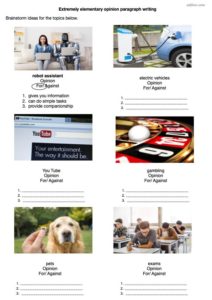
Elementary opinion writing lesson (PDF)
Related Resources:
8 comparison/contrast templates and exercises
10 cause/effect writing activities
3 kinds of exercises for teaching transitions
6 memorable narrative essay writing practice exercises (PDF)
6 delightful descriptive paragraph and essay writing exercises (PDF)
11 essential exercises for elementary writing students (PDF)
9 exercises for writing process essays
4 Brainstorming controversial Issues (opinion/argument essay icebreaker)
This exercise is a great way to get students started on opinion or argument essay writing. It’s a brainstorming worksheet for controversial issues. Students try to fill the worksheet in with appropriate topics, sub-topics and questions about controversial issues.
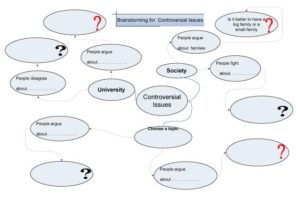
Brainstorming controversial issues(PDF)
5 Brainstorming for an argument essay exercise
This is a brainstorming template for an argument or opinion essay. Students choose a topic for their essay, write it in the centre of the worksheet and then brainstorm the benefits/disadvantages ..pros/cons …etc.
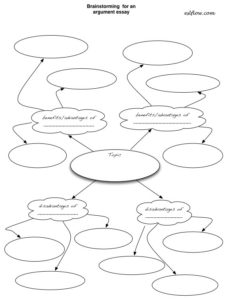
Brainstorming for an argument essay (PDF)
6 ‘Distracted Driving” Opinion Essay Outline Exercise (with answers)
This is a matching exercise for an opinion essay outline. Students have to match the sentences of an essay about distracted driving on page 2 to the correct parts of the essay outline on page 1. This helps reinforce or review students’ knowledge of essay structure. Answers are provided on page 3 of the PDF file.
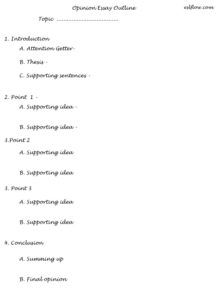
Opinion essay outline matching exercise (PDF)
7 Opinion essay box outline template/worksheet
This is an outlining exercise for an opinion essay. Students choose a topic for their essay and then try to plan their essay by filling out the worksheet with ideas and information appropriate to each part of the essay. The first page of the PDF worksheet has an example essay template already filled out for reference.

Opinion essay box outline template/worksheet (PDF)
8 Opinion paragraph outline exercise: Uniforms
As above , this is another exercise practicing the outlining of an opinion paragraph. Also, before this exercise, it could be a good idea to brainstorm about uniforms. Click here for brainstorm worksheet
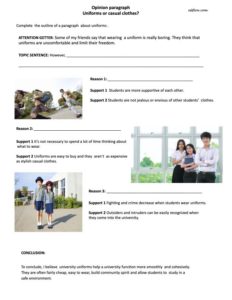
“Uniforms or Casual Clothes” outline worksheet (PDF)
9 Opinion paragraph outline exercise: “Lotteries”
This an exercise for practicing the outlining of an opinion paragraph. Students look at the information already filled in. Then they complete the outline with their own ideas.
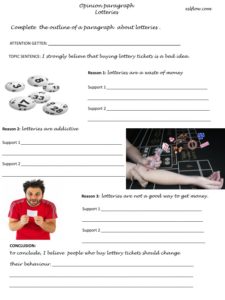
Lotteries outline worksheet (PDF)
10 Writing opinion sentences about new technologies (with answers)
This worksheet that can be used to help students improve their writing skills and express their opinions about automated and robotic technologies including driverless vehicles, smartphone payments and smart watches.
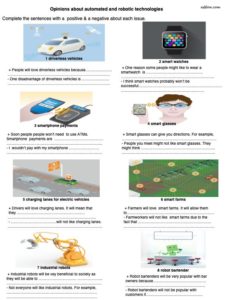
Writing opinion sentences about automated devices/new technologies (PDF)
11 Opinion essay exercise: “Autonomous Vehicles”
This is English language exercise for practicing essay writing. The topic is Students look at the information already filled in. Then they complete the essay with their own ideas.

Autonomous vehicles essay writing practice (PDF)
11 Classroom Debate and Discussion Language and Critical Thinking Activities
8 Dynamic Classroom Brainstorming Techniques
6 ESL Exercises and Worksheets for Talking about Cities
15 Captivating Computing, Technology and Innovation Vocabulary and Language Exercises
12 Argument essay: advantages /disadvantages of starting a small business
This an argument essay exercise including a brainstorming activity to generate language and vocabulary about the advantages and disadvantages of starting a small business followed by an outlining exercise for an essay on this topic.

Advantages/disadvantages of starting a small business(PDF)

6 Replies to “Essential opinion and argument paragraph and essay writing worksheets”
Hey, anyone who uses these exercises. I’d appreciate a comment…..
They are great and appreciated!
thanks a lot i do appreciated what you have done
Good activities for the special ed. crowd.
good exercises for beginners
Thank you! Using these with inmates studying for the GED.
Leave a Reply Cancel reply
Your email address will not be published. Required fields are marked *
Save my name, email, and website in this browser for the next time I comment.
This site uses Akismet to reduce spam. Learn how your comment data is processed .
RECENT ESL EXERCISES
- Essential listening exercises for ESL classes
- Daily routines and schedules
- Sentence starters
- Writing topic sentences
- Shopping online listening, speaking and vocabulary
- Import/export, logistics and supply chain exercises
- Create a conversation
- Using comparative adjectives
- Gerunds and Infinitives Grammar, Speaking and Listening Activities
Analyze an Argument: Practice 1 (English I Reading)
Introduction, what does evidence look like, what counts as evidence, how good is the evidence.
Copy and paste the link code above.
Related Items

Addition (Basic)
Addition (Multi-Digit)
Algebra & Pre-Algebra
Comparing Numbers
Daily Math Review
Division (Basic)
Division (Long Division)
Hundreds Charts
Measurement
Multiplication (Basic)
Multiplication (Multi-Digit)
Order of Operations
Place Value
Probability
Skip Counting
Subtraction
Telling Time
Word Problems (Daily)
More Math Worksheets
Reading Comprehension
Reading Comprehension Gr. 1
Reading Comprehension Gr. 2
Reading Comprehension Gr. 3
Reading Comprehension Gr. 4
Reading Comprehension Gr. 5
Reading Comprehension Gr. 6
Reading & Writing
Reading Worksheets
Cause & Effect
Fact & Opinion
Fix the Sentences
Graphic Organizers
Synonyms & Antonyms
Writing Prompts
Writing Story Pictures
Writing Worksheets
More ELA Worksheets
Consonant Sounds
Vowel Sounds
Consonant Blends
Consonant Digraphs
Word Families
More Phonics Worksheets
Early Literacy
Build Sentences
Sight Word Units
Sight Words (Individual)
More Early Literacy
Punctuation
Subjects and Predicates
More Grammar Worksheets
Spelling Lists
Spelling Grade 1
Spelling Grade 2
Spelling Grade 3
Spelling Grade 4
Spelling Grade 5
Spelling Grade 6
More Spelling Worksheets
Chapter Books
Charlotte's Web
Magic Tree House #1
Boxcar Children
More Literacy Units
Animal (Vertebrate) Groups
Butterfly Life Cycle
Electricity
Matter (Solid, Liquid, Gas)
Simple Machines
Space - Solar System
More Science Worksheets
Social Studies
Maps (Geography)
Maps (Map Skills)
More Social Studies
Mother's Day
Father's Day
More Holiday Worksheets
Puzzles & Brain Teasers
Brain Teasers
Logic: Addition Squares
Mystery Graph Pictures
Number Detective
Lost in the USA
More Thinking Puzzles
Teacher Helpers
Teaching Tools
Award Certificates
More Teacher Helpers
Pre-K and Kindergarten
Alphabet (ABCs)
Numbers and Counting
Shapes (Basic)
More Kindergarten
Worksheet Generator
Word Search Generator
Multiple Choice Generator
Fill-in-the-Blanks Generator
More Generator Tools
Full Website Index
Persuasive Writing
Use these worksheets to supplement your persuasive writing unit. Includes a variety of worksheets and writing prompts for students.
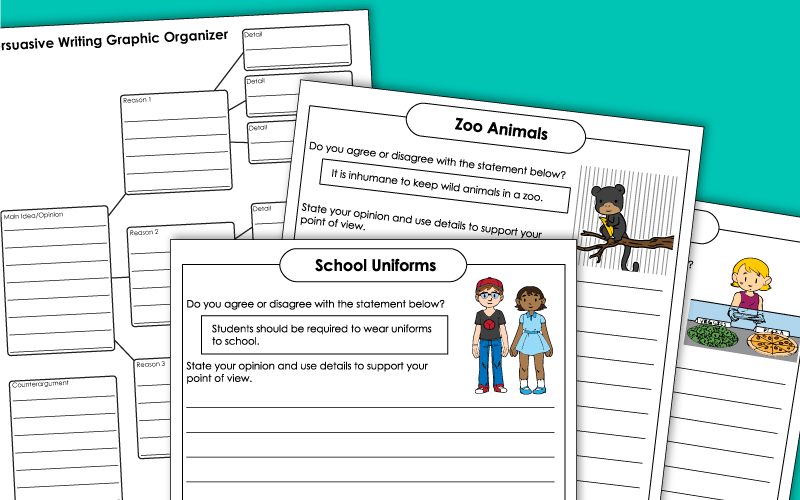
Persuasive Writing Topics

Logged in members can use the Super Teacher Worksheets filing cabinet to save their favorite worksheets.
Quickly access your most used files AND your custom generated worksheets!
Please login to your account or become a member and join our community today to utilize this helpful feature.

Opinion Piece Response
Graphic organizer.
Write creative stories and thoughts based on these fun writing prompts.
Color the pictures and write creative stories to explain what's happening in each scene.
Learn to write thank you notes and friendly letters. Also includes worksheets of figures of speech, editing, and writing projects.
Print editing wheels, proofreading bookmarks, and short passages for students to proofread.
Sample Worksheet Images
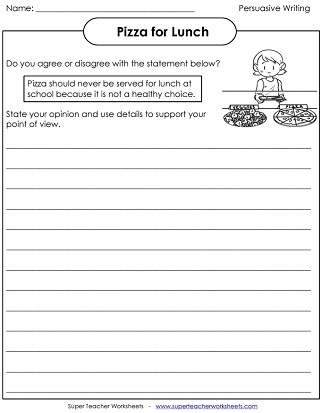
PDF with answer key:
PDF no answer key:

IMAGES
VIDEO
COMMENTS
Matthew Barbee, 2015 1 Name_____ Class_____ In an argumentative essay, your job is make the reader agree with your opinion about a controversial topic. You have to (1) state your opinion, (2) give reasons to support your opinion, and (3) argue against the opposite opinion. Overall, you must convince the audience that your side of the
Argumentative Essay Revised by: Brandon Everett Created by: Chris Kildegaard Revised, Fall 2019 An Argumentative, or position, essay is a common genre of academic writing. It requires you to investigate a topic; collect, create, and evaluate evidence; and then establish a position on the topic in a concise manner.
Argumentative Essay Practice Exam Time: 60 minutes Directions: Closely read each of the four texts provided and write a source-based argument on the topic below. You may use the margins to take notes as you read and scrap paper to plan your response. Topic: Should students wear school uniforms? Your Task: Carefully read each of the two texts ...
An exercise in literary self-expression. A report of what various scholars have had to say on a particular topic. A presentation of the latest findings of tests or experiments A presentation of your personal feelings or impressions. So what is an argumentative essay? A position paper or argumentative essay may involve research for facts to ...
Look at the essay and do the exercises to practise and improve your writing skills. Preparation Are these arguments for or against reality TV shows? Write them in the correct group. There are lots of different types of reality shows. Some competitions are very difficult or dangerous. People on reality shows have fun experiences and meet new people.
In Writing Task 2, test takers will be asked to write an essay in response to a point of view, argument or problem. They will be expected to write at least 250 words and are advised to spend 40 minutes on this task. The essay should be written in formal, academic English. Time 45 minutes (90 if doing writing in class)
Bonus exercise: See if you can identify the "template" structure that each of the sentences below is using (hint, they are different from the templates provided above). Brown (2018) rejects the idea that the levels of climate change we are currently seeing can be considered "natural" or "cyclical" (p. 108).
378 CHAPTER 13 Writing Argumentative Essays W RITING A SUCCESSFUL ARGUMENT Writing takes place in three very broad stages: • what you do before you begin writing • what you do when writing the fi rst draft • what you do after you've completed your draft This chapter shows you how to prepare and write an argument, but you should keep one important point in mind as you read: Although ...
4. Write a rough draft. Now at last you are ready to start writing your paper. Start with a short introduction paragraph and then use your outline to draft the body and conclusion. Don't forget to begin each paragraph in the body with a topic sentence that conveys the main argument of that paragraph.
Body paragraph #4: Writing the opposing argument. 1) The opposing argument, called the counterclaim or counterargument, proves that you fully understand the topic and that you have considered the opposition. 2) The turn-back is a return to the original argument. It gives you an opportunity to prove why the opposing argument is invalid.
essay. _____ At least one text structure (sequence, cause/effect, problem/solution, topic description, compare/contrast) is used to organize information in the article. _____ Research information is clearly integrated into the text to provide support for the argument. _____ The essay includes at least 4 complete (4-5 sentence) paragraphs.
When an argumentative essay is assigned by your teacher , it is important to distinguish whether the assignment asks you to : a) Present both sides of the issue equally and objectively OR b) Present your position on the issue as stronger than the opposing position Your thesis statement must reflect clearly the purpose of your essay assignment. ...
Argumentative Essays - Opinion Essays. ESS010 - Basic Income. ESS009 - Strict Parenting. ESS008 - Visiting Museums. ESS007 - Vegetarianism. ESS006 - School Sports. ESS005 - Cyberbullying - Opinion Essay. ESS001 - Shopping Mall or Sports Ground - Argumentative Essay. ESS002 - Computers and the Internet.
Argumentative Essays writingcentre.stu.ca Argumentative essays are also known as "persuasive essays," "opinion essays," or "position papers." In ... First, the internet is good for democracy because it lets citizens exercise their freedom of spee ch. explain the logic of that reason , and provide examples, facts, and statistics
Beyond that, there are a few more tricks that one can use to enhance one's skills quickly. These persuasive essay worksheets and activities will help students master these tricks. Creating Persuasive Attention Catchers Activity - Students practice creating persuasive leads that immediately push the reader toward their side of the argument.
Make a claim. Provide the grounds (evidence) for the claim. Explain the warrant (how the grounds support the claim) Discuss possible rebuttals to the claim, identifying the limits of the argument and showing that you have considered alternative perspectives. The Toulmin model is a common approach in academic essays.
typical place for teenagers to play truant. malls organise. Exercise 3 Think carefully about what your opinion is on the topic from Exercise 1. Write your thesis under the heading Introduction. Then write down the arguments you would like to use in your essay. Introduction. Paragraph 1: employment.
This exercise is a great way to get students started on opinion or argument essay writing. It's a brainstorming worksheet for controversial issues. Students try to fill the worksheet in with appropriate topics, sub-topics and questions about controversial issues. Brainstorming controversial issues (PDF)
Logical, compelling progression of ideas in essay;clear structure which enhances and showcases the central idea or theme and moves the reader through the text. Organization flows so smoothly the reader hardly thinks about it. Effective, mature, graceful transitions exist throughout the essay.
Downloads: 9. Argumentative essay topics and argument tables. Level: advanced. Age: 14-17. Downloads: 10. A collection of downloadable worksheets, exercises and activities to teach Argumentative essay, shared by English language teachers.
Share. You will be able to analyze the quality, relevance, and credibility of evidence that supports or opposes an argument.
This printable graphic organizer will help students organize their writing. The worksheet has boxes for students to write an opinion, reasons, details, and a counterargument. 3rd through 6th Grades. View PDF. Persuasive Writing Graphic Organizer (with Lines) This is a different version of the above graphic organizer.
ARGUMENTATIVE RESEARCH PAPER. Knowing how to create an argumentative research paper is essential to your achievement in university because you will be assigned to make persuasive resear... 67 uses. A selection of English ESL argumentative essay printables.